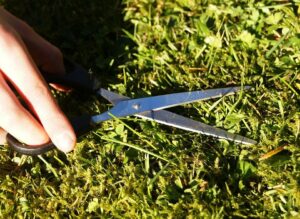America’s number one grass is a beautiful addition to your Australian backyard.
Kentucky Bluegrass has been the favourite of North America for decades, but surprisingly, not in the state after which it is named. Kentucky Bluegrass is suited to cooler, more moist climates, with crisper winters. Kentucky, like much of Australia, is warmer and more humid than the grass will commonly appreciate.
That does mean that its suitability in Australia is limited to the more temperate, southern reaches. But if your climate suits, it can make for one of the most beautiful lawns available.
The bluish tinge that shows on its deep green, boat shaped blades makes Kentucky Bluegrass one of the most eye-catching lawns you can grow. And its excellent traffic tolerance will mean that it can be enjoyed for years to come.
So you’ve chosen Kentucky Bluegrass, and you want to not only get it growing, but keep it looking its best. How should you go about it?
Here are six care and maintenance tips to help your Kentucky Bluegrass not only survive, but thrive.
Sowing the Seed
Ideally you’ll want to sow your seed in autumn, and it take best if it’s planted in a predominantly sunny area, particularly if your winters are colder. This may mean trimming back any overhanging bushes or trees to give your seed the best start in life.
Ensure that your soil is well drained, and is covered with plenty of organic matter. A pH test of your soil may be an idea – Kentucky Bluegrass thrives in those that are neutral to slightly acidic, with a pH of 6.5 – 7. If your soil falls outside of this range, you can use soil additives to adjust the levels.
When sowing, seeds that are planted 2cm below the surface will germinate quicker than those that are simply sown on top, and the planted seeds will be less prone to becoming bird feed. If possible, spread a layer of topsoil over your freshly sown seeds to get them covered.
Blending in Other Seed
Kentucky Bluegrass can be complemented nicely by another grass if sown together.
Perennial Ryegrass or fine fescue will bring other strengths to the table, without detracting from the look of your lawn.
Give it a Drink
When freshly sown, try to keep the soil semi-moist constantly by watering the area 2-3 times a day. After a couple of weeks, once the seeds have germinated, you can scale this back to once a week.
Once established, this once-a-week routine will only need to be altered in dry, hot conditions. When the mercury hits 30C, your Bluegrass will go dormant, which you should allow. During this dormant period, give the grass a very light water just once a fortnight.
And don’t fret, your lawn will be as good as new once the heat passes.
Time for a Haircut
After germinating, you want to allow Kentucky Bluegrass to get to a height of a good 12cm or so before bringing out the mower. This allows the grass to spread, and crowd out any weed growth.
Thereafter, mow Kentucky Bluegrass regularly, cutting it down to 5-8cm. When it reverts to dormancy in the heat of summer, hold off on mowing. You also ideally want to give it a break in early autumn to allow it to collect carbohydrates.
Take it to Dinner
For the best looking lawn on the block, a good fertilisation schedule will have it going gangbusters.
When first sown, use a seeding fertiliser with phosphorous combined with a nitrogen-heavy lawn fertiliser to promote healthy growth. A winterising slow release fertiliser spread in late autumn will help your Bluegrass deal with the first cold snap, keeping it healthy over those frosty winter months.
Pests and Diseases
Pests and diseases will usually try to attack your Kentucky Bluegrass when it falls into dormancy in the summer heat. Keep a close eye on any potential beetle or grub infestations, and attack with insecticide if anything crops up.
There are Bluegrass strains that have been specifically developed to be better at staving off disease, but blending your seed with another variety like ryegrass will also help the cause.
As always, for any other Kentucky Bluegrass maintenance queries, contact your friendly McKays’ seed specialist.



